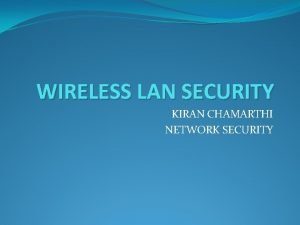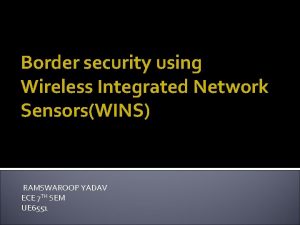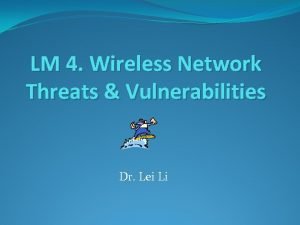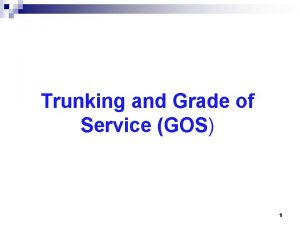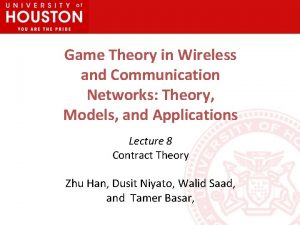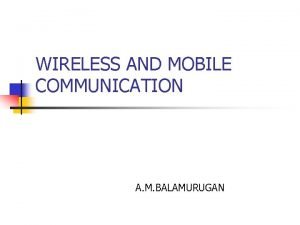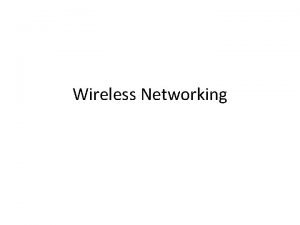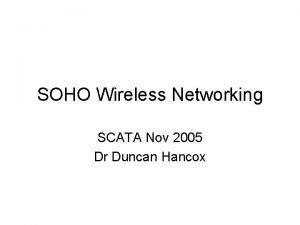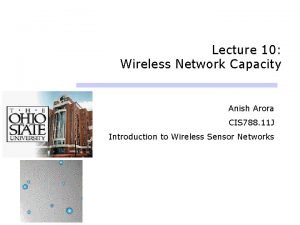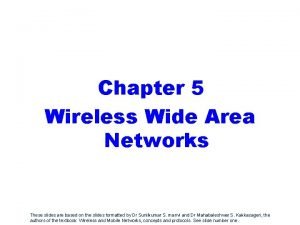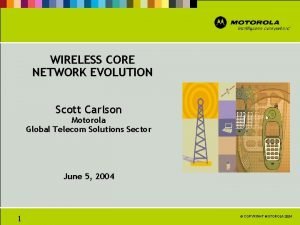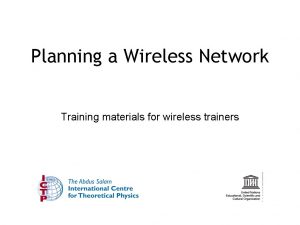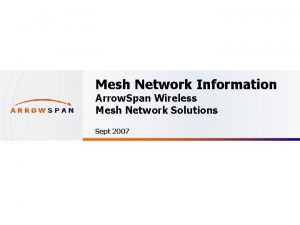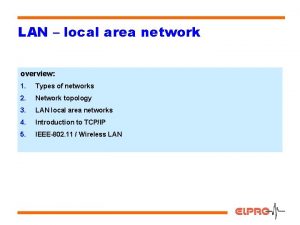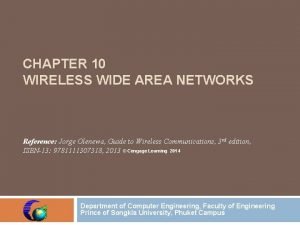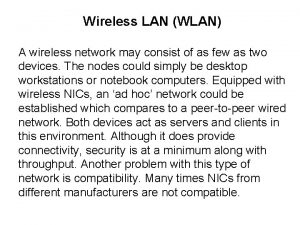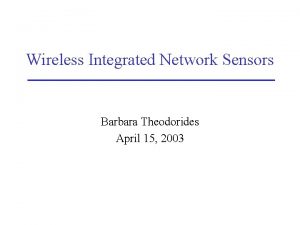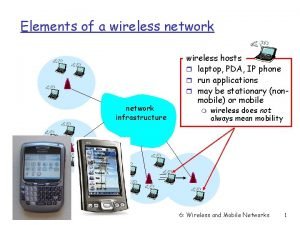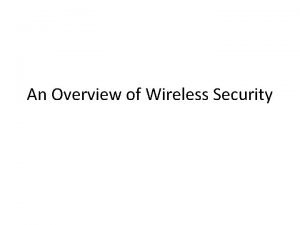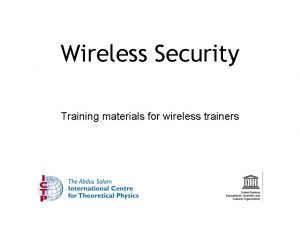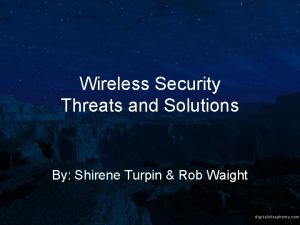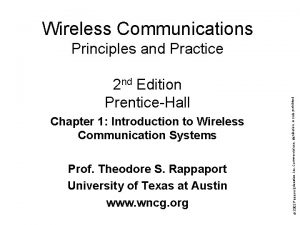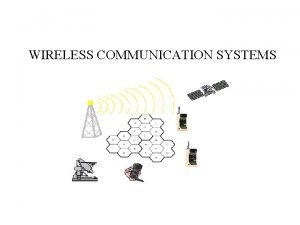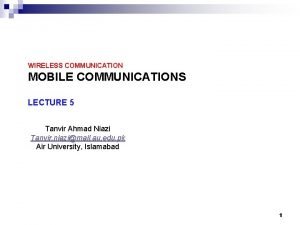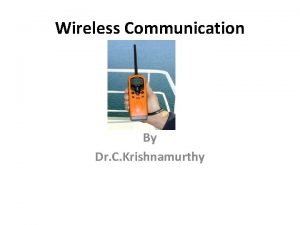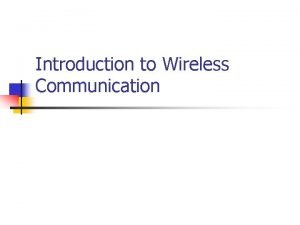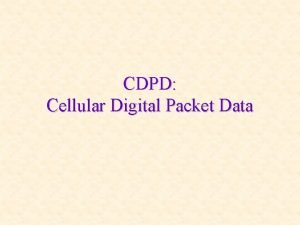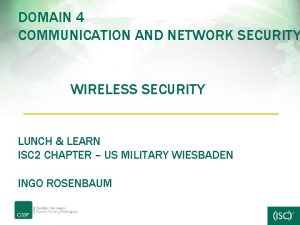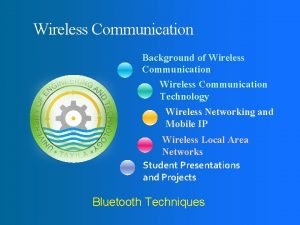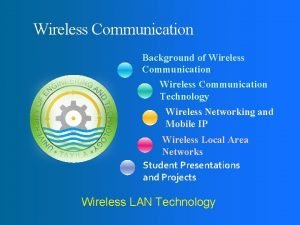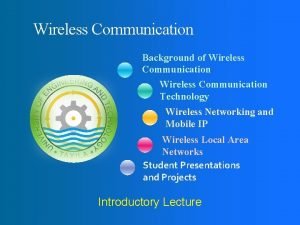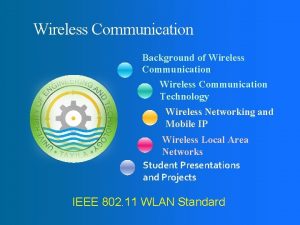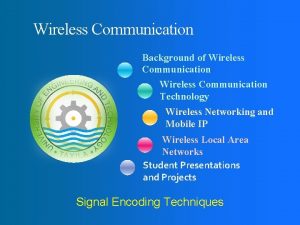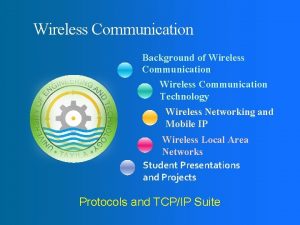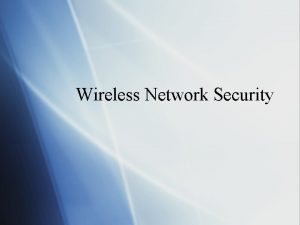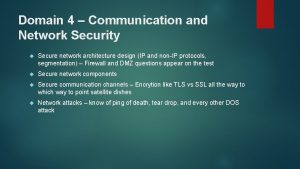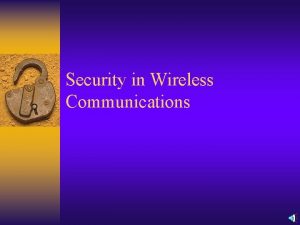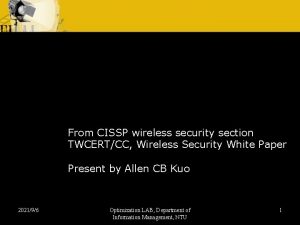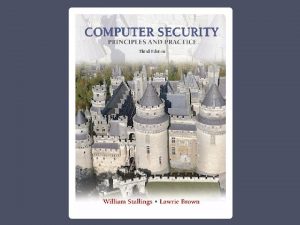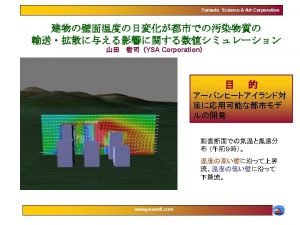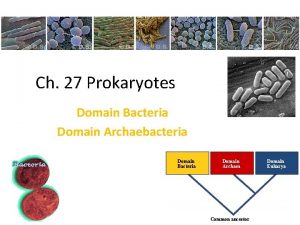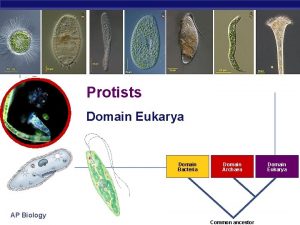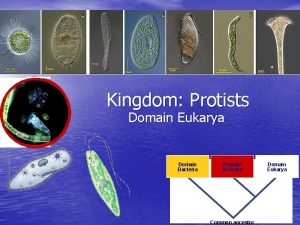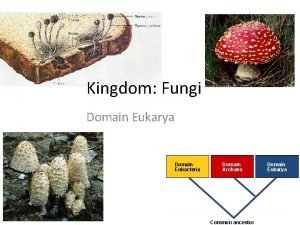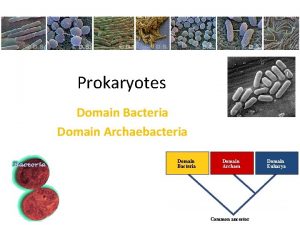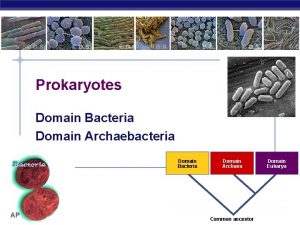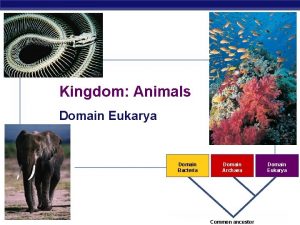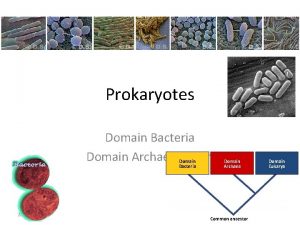DOMAIN 4 COMMUNICATION AND NETWORK SECURITY WIRELESS SECURITY












































- Slides: 44

DOMAIN 4 COMMUNICATION AND NETWORK SECURITY WIRELESS SECURITY LUNCH & LEARN ISC 2 CHAPTER – US MILITARY WIESBADEN INGO ROSENBAUM

Agenda: • • Wi-Fi Basics – Physical and Network Wi-Fi History Wi-Fi Components and Topology Wireless Security Issues Attack Vectors, Threats and Vulnerabilities Protection and Hardening Outlook FAQs 2

Wi-Fi Basics – Physical and Network 3

4

WLAN – RF Modulation and Bandwith • WI-FI is operating in the ISM Band (Industrial, Scientific, Medical) • Ranges from 2. 4 GHz up to 5. 8 GHz • Fundamentals: Amplitude-/Frequency-/Phase-Shift Keying • Frequency Hoppying Spread Spectrum FHSS • Direct Sequence Spread Spectrum DSSS • Orthogonal Frequency-Division Multiplexing OFDM 5

OFDM – Current standard • OFDM is NOT a spread spectrum technology • Multicarrier Frequency Domain Multiplexing Modulation Technology • Orthogonal… what the heck does this mean? – In Mathematics it has got multiple meanings: - Two segments are „orthogonal“ to each other if they form a right angle - By extension, orthogonality is used to refer to the seperation of specific features of a system - Euclidean vector spaces - Orthogonal integral functions etc. • In communications, multiple-access schemes are orthogonal when an ideal receiver can completely reject arbitrarily strong unwanted signals from the desired signal using different basis functions. 6

OFDM 7

WI-FI History 1/3 • IEEE 802. 11 – September 1997 – Specs for PHY and MAC Layer (ISO-OSI) • IEEE 802. 11 a – September 1999 – 5 GHz, 54 MBit/s – OFDM => Regul. Restriction in some Countri • IEEE 802. 11 b – December 1999 – 2, 4 GHz, 11 MBit/s – DSSS => Widely adopted e. g. Apple i. Book plus Air. Port Support • IEEE 802. 11 g – June 2003 – 2, 4 GHz, 54 MBit/s – OFDM -> – Transmit Power Control TPC – Dynamic Frequence Selection DFS 8

WI-FI History 2/3 • IEEE 802. 11 n – September 2009 – Dual Band (2, 4 and 5 GHz), 600 MBit/s MIMO-OFDM, Transmitting of different Signals at the same time ->Spatial Streams 4 x 4: 4 -> 1 st number: max number of Transmitting Antennas 2 nd number: max. number of Receiving Antennas 3 rd number: max. number of Spatial Streams • IEEE 802. 11 ad – December 2012 – Wireless Gigabit (Wi. Gig), Operation Range 57 -66 GHz – Transition between WLAN-WPN -> short distance but High Throughput (4 K-HDR with 60 fps) 9

WI-FI History 3/3 • IEEE 802. 11 ac – December 2013 – 5 GHz only, New Concept of „WAVE“ means new standards and Technology implementation -> Bandwith up to 3, 4 GBit/s – WAVE 2 –Multi-User MIMO – MU-MIMO – Beamforming • IEEE 802. 11 ax– January 2020 – Wi-Fi 6 – 5 GHz, up to 4, 8 Gbit/s 8 x 8 OFDMA – Backwardcompatible to older standards a, b, g, n, ac – Io. T applications 10

Additional Standards • IEEE 802. 15 – Bluetooth WPAN 2, 4 GHz, max. 100 m. W -> 5 -20 m Range • IEEE 802. 15. 4 – Zig. Bee Smart Home • IEEE 802. 16 – Wi. Max – WAN–Wi-Fi – Frequency Range: 2 -66 GHz up to 1 GBit/s – Max. Transmitpower: 30 W – Operational Range: up to 50 km 11

IEEE 802. 11 w • IEEE 802. 11 w -> Protected Management Frame (2009) • Concept for encrypted and cleartext management exchange frames between STA and AP • Encrypted PMF: – Disassociation – Deauthentication Both execute the termination of a connection: – Action-Frames (e. g. Channel Switch Announcement) – 802. 11 k-Frames ( Radio Measurement Action for Infrastructure BSS) 12

IEEE 802. 11 w • Non-Encrypted PMF: – Beacon: permanent sending SSIDs and status frames – Probe Request and Response: Active probing frames sending from STA to AP – Association Request and Response: Information exchange about synchronization and datarate – Re-association Request and Response: Information exchange about better AP range ->Roaming – Announcement Traffic Indication Message – Authentication -> usually first request open, due to Challenge -Response „go-for“ encryption 13

IEEE 802. 11 w • Broadcast Frames are non-encrypted • 802. 11 w gets rid of „Spoofed Disconnect“ Do. S attacks resulting from spoofing of – Deauth / Disassoc / Assoc Request or Auth Request in existing connection • Certain „Action Managment Frames“ are also made anti-spoofing – Spectrum Management, Qo. S, Block. Ack, Radio Measurement, Fast BBS Transition • ATTENTION: In many clients PMF is deactivated or not supported 14

Wi-Fi Components and Topology • WNIC: Wireless Network Interface Card – Mostly inbuild in STA, older implemetation are based on PCMCIA, Smart. Cards Modules or USB Dongle • STA: – Stations (Computer, Laptops, Smartphones, Tablets, Io. TDevices, etc. ) • Access Points: – Networking hardware device allowing WI-FI Stations/Devices to connect to a wired network • WLAN/Wi-Fi Controller: – Management and Configuration of Enterprise Wi-Fi Networks 15

Wi-Fi Topology • IBSS: Independet Basic Service Set – Ad-hoc Network, 2 or more STA connects directly without A • BBS: Basic Service Set – Stations connect to an Access Point. Max. 100 Clients per AP, AP is connected via Ethernet to Network • ESS: Extended Service Set – More than one AP is connected to the Ethernet. Roaming available – Site-Survey essential • WDS: Wireless Distribution Service – Repeater – receive weak signal, amplify and resend 16

WI-FI Security 17

Wireless Security Issues • No Cable. . Direct and open access to radio signal => Easy Sniffing, only weak signal or radio transmitting protection/shielding mechanism can work • First Implementation of Wi-Fi -> very weak security (WEP) • No or very weak authentication – SSID as a name for a Wi-Fi network is easy to detect and often in cleartext 18

WEP Security Issues • Wired Equivalent Protection WEP – Intro in 1997 and ratified as a Wi-Fi security standard in 1999 • Intended confidentiality comparable to Wired Network • Uses stream cipher RC 4 for confidentiality and CRC-32 checksum for integrity • 64 -bit, 128 -bit, 152 -bit and 256 -bit Key implementations are available • Very simple encryption scheme – RC 4 Keystream XORed with Plaintext 19

WEP Security Issues • 2 Authentication Methods available: – Opens System Auth No authentication occurs as STA does not provide credentials to AP – Shared Key Auth – WEP key is used – 4 -step challenge response handshake: 1. The client sends an authentication request to the Access Point. 2. The Access Point replies with a clear-text challenge. 3. The client encrypts the challenge-text using the configured WEP key and sends it back in another authentication request. 4. The Access Point decrypts the response. If this matches the challenge text, the Access Point sends back a positive reply. 20

WEP Security Weakness • Open System: Transmitting the secret key uncrypted in the Management Frames • Shared Key: To decrypt data stream capturing the challenge frames in Sk-auth could derive the keystream and therefore the original key -> See WEP-Attacks later in the presentation NEVER USE WEP !!! 21

Wi-Fi Protected Access WPA • WPA – IEEE 802. 11 i introduced in 2003 • WPA-Personal aka WPA-PSK – Primarily designed for Small/Home Office networks – No authentication server required -> Use passphrase of 8 to 63 ASCII character – Using ASCII charactes the 256 -bit shared key is calculated by appliy PBKDF 2 key derivation function to the passphrase, using SSID as the salt plus 4096 iterations of HMAC-SHA 1 22

WPA: Wi-Fi Protected Access • IEEE 802. 11 i – Overview • WPA 1 – Temporal Key Integrity Protocol – TKIP – Message Integrity Check – Part of TKIP (Michael) – Key Mixing – Part of TKIP • WPA 2 – Implementing Counter Mode Cipher Block Changing CCMP, an AES-based encryption mode • WPA 3 – Introduction of an Enterprise mode (AES-256 in GCM mode with SHA-384 as HMAC) 23

WPA Terminology • WPA-Enterprise aka WPA-802. 1 X-2004 Mode – Designed for enterprise networks using RADIUS – Various Use of Extensible Authentication Protocol EAP, which is a authentication framework. There almost 40 different methods available. Some of the most common are: • EAP-Transport Layer Security -> EAE-TLS • EAP Lightwight Extensible Authentication Protocol -> EAP-LEAP • EAP Internet Key Excnage v. 2 -> EAP-IKEv 2 • Wi-Fi Protected Setup WPS – Mostly commercial products – Easy key distribution methode but contains a major security hole via WPS PIN Recovery -> DO NOT USE 24 IT !!

WPA: Wi-Fi Protected Access EAP Method Re-Keying Mut. -Auth. Clientcertificat e Tunnel Standard WPA comp EAPMD 5 NO NO YES NO LEAP YES NO NO YES/NO YES EAP-TLS YES YES NO YES PEAP YES NO YES YES EAP-SIM YES NO NO YES EAPFAST YES NO YES/NO YES 25

Attack Vectors, Threats and Vulnerabilities Traditional RF-Attacks • Radio Jamming – Deliberate blocking or interference with authorized wireless communication – Distinction between „jamming“ and „interference“ • Jamming describes the DELIBERATE Use of radio noise or signals in an attempt to disrupt communication • Interference describes the UNINTENTIONAL forms of disruption due to malfunction or misconfiguration • In most countries jamming is highly illegal => DON´T DO IT !! 26

Jamming 27

Mobility Attack -> WARDRIVING • Wardriving is a form of reconnaissance • Usually used to find open Hotspots in towns, organisations, industrial plans, etc. • There are no laws that specifically prohibit or allow wardriving • Passive listening (Kismet or Kis. MAC) similar to listen /receiving radio signals from a TV/radio broadcast station • Another form is warbiking https: //vimeo. com/93257547 28

Attack Vectors • In general, as Wi-Fi is just another OSI Layer 1 / Layer 2 technology attack vectors for TCP/IP and layer above still remains – – – Denial of Service Attacks ( Do. S or DDo. S) Spoofing MAC Addresses Malware/Ransomware Attacks Advanced Persistance Threats – APTs Rootkits, RATs and Keylogger Social Engineering 29

Attack Vectors • Wi-Fi specific Attacks > Trivial and non-trivial • Trivial: – Access to an open Wi-Fi Network – Access to Wi-Fi without actively sending SSID – Access to Wi-Fi with MAC Filters • Non-Trivial: – WPA 1/2/3 encrypted Wi-Fi Network – Rogue Access Points – Evil Twin Attacks – KRACK IS WEP Cracking trivial? Lets have a look in detail…. . 30

WEP Attack 1/5 • Getting the WEP Key via AP and STA • IV –> Initialization Vector -> concatinate with WEP-Key Keystream • Problem: Avoid using the same IV while joining a Wi-Fi Network…. This can happens when hunderts of thousands repetition occour -> IV Collision • How to provoke a collision? – Passive listening to hundreds of STA during long time – ARP Replay Attack by using MAC Spoofing 31

WEP Attack 2/5 Theoretical Example Sniffed Paket 2 Sniffed Paket 1 Clear Text 1 Keystream 1 Secret Text 1 Clear Text 2 1110 1011 Keystream 2 XOR 0101 1111 Secret Text 2 1011 0100 XOR 0101 1111 1001 1010 XOR of Clear Texts XOR of Secret Texts Secret Text 1 1100 0101 Clear Text 1 1011 0100 1110 1011 Secret Text 2 XOR 1001 1010 Clear Text 2 XOR 1100 0101 Result 0010 1110 Same Value 32 0010 1110

WEP Attack 3/5 Evidence and Proof Assume, that Clear Text 1 and both Keystreams are known Proof to obtain Clear Text 2 Result XOR Secret Texts Clear Text 1 0010 1110 XO R Clear Text 2 1110 1011 1100 0101 IF Clear Text + Keystream = Secret Text THEN Clear Text + Secret Text = Keystream Known Plaintext Attack 33

WEP Attack 4/5 Practical Example • General technical concept of a WEP Attack • Usage of a WLAN hacking tool like Kismet-Newcore or Aircrack –NG • Target is to find a cleartext - two ways to accomplish • Sending targeted packets to AP and forcing response • Passive listening to standard procedures (e. g. Handshake TCP/IP or DHCP protocol) 34

WEP Attack 5/5 • Gathering/sniffing and storing Wi-Fi network traffic – minimum of 100. 000 packets, better more depending of traffic volume and cracking computer power of attack PC ( Core i 7/i 9 – 3 GHz+ – 16 GRAM+ – GTX 1060/RX 480 above recommended) ARP Replay attack: aireplay –ng -3 –arpreplay –b <MACAddr AP> -h <MACAddr STA> -r Capfilename. cap wlan 0 • -3 means standard arp request replay • Aircrack does the work – reading packets and counting the IVs • Searching for IVs and collisions • After a while aircrack provides the WEP key 35

Attack Vectors • Non-Trivial: – – WPA 1/2/3 encrypted Wi-Fi Network Rogue Access Points Evil Twin Attacks KRACK 36

Attack Vectors - WPA • WPA correctly implemented is very secure • Uses the AES encryption scheme…. Unbreakable so far ( unless post-quantum cryptoanalysis will work • Only way is to find weak PSKs (8 -63 characters). • To start a WPA attack aka WPA Cracking makes sure that – WLAN Router does not have standard password – No WPS vulnarabilty exists • Dictionary Attack to find the PSK is most efficient 37

Attack Vectors - Rogue APs • Nightmare of any Security/Network Administrator or IT-Security Manager • Hidden / Shadow IT Problem • Easy implementation by tethering (Smartphone, Tablets, Laptops, etc) • Connection via 4 G to the Internet – Classic FWs or Webproxies fails • Protection: Wi. Fi-IDS/IPS, SIEM and NG-Endpoint • ATTENTION: In Pen. Test Szenario get permission for using Rogue APs In US and EU considered a severe act 38 of espionage and cybercrime

Attack Vectors - Evil Twin • Evil Twin Attack simply means there is another AP (Rogue) to pretend to be the correct and authorised AP to which a client can be connected • Often happens in Hotspots (Restaurants, Bars, Airports, etc. ) • Providing Fake web-GUIs • A little bit of phishing required – social engineering • Good tool is wifiphiser (integrated in Kali Linux) 39

Attack Vectors - KRACK • Key Reinstallation Attack -> KRACK • Replay Attack on WPA 2 – CVE 2017 -13077 • Inherent vulnerabilty in the 4 -way handshake of the Wi-Fi Protected Access II security protocol • Effects all major software platforms incl. Microsoft Windo Mac. OS, i. OS, Android, Linux, Open. BSD, etc. • How to protect? – Install latest Patch from vendors -> might be very seldom – Useage of WPA 3: Replace PSK exhange with Simultaneous Authentification of Equals SAE 40

Wi-Fi – How to protect? TOP 10 Rules for a secure Wi. Fi-Network operation 1. 2. 3. 4. 5. 6. 7. Do not use Standard Passwords, SSIDs, Routerpasswords Usage of strong passwords plus Passwordmanager Only WPA 2 or WPA 3 for Authentification Deactivate WPS Enterprise environment -> WPA 2 Enterprise environment -> specialized Wi-Fi IDS and/or IPS Multiple Wi-Fi Networks -> Guest-Wi-Fi, Conference-Room Wi-Fi, etc. 8. Usage of Protected Management Frames PMF 9. Home Wi-Fi: Changing PSK 1 -4 times per year 10. Usage of Firewalls (Inbuild in So. Ho Router or external/additional) 41

FINISH THANK YOU VERY MUCH FOR YOUR ATTENTION YOURS INGO ROSENBAUM STAY HAPPY AND HEALTHY 42

Sources • Books: WLAN Hacking: Tim Philip /Rico Walde – German Network Hacking: Dr. Peter Kraft/Andreas Weyert – German 802. 11 Wirless Networks: Matthew S. Gast – English The Hacker Playbook 2: Peter Kim – English Wireshark 101: Laura Chappell All In One CISSP: Shon Harris • Links https: //en. wikipedia. org/wiki/Wireless_security https: //de. wikipedia. org/wiki/IEEE_802. 11 https: //en. wikipedia. org/wiki/Orthogonal_frequency-division_multiplexing https: //en. wikipedia. org/wiki/Extensible_Authentication_Protocol< 43

Sources • Video / Online Tutorials https: //www. youtube. com/watch? v=qsm. YD_6 Ae. IU https: //www. slideshare. net/Air. Tight. WIPS/80211 w-is-ratified-so-whatdoes-it-mean-for-your-wlan https: //www. slideshare. net/wildpackets/80211 -2012 -update https: //www. slideshare. net/oded 1233/80211 p? next_slideshow=1 https: //www. youtube. com/watch? v=PHo. LD 91 q. E 5 A 44
 Wireless security in cryptography
Wireless security in cryptography What are wireless devices and the wireless revolution
What are wireless devices and the wireless revolution Wlan meaning
Wlan meaning Wireless integrated network sensors
Wireless integrated network sensors Wireless security threats and vulnerabilities
Wireless security threats and vulnerabilities What is grade of service
What is grade of service Game theory in wireless and communication networks
Game theory in wireless and communication networks Mobile and wireless communication syllabus
Mobile and wireless communication syllabus Domain and range games
Domain and range games Time domain and frequency domain
Time domain and frequency domain Language processor mcq
Language processor mcq What is the osi security architecture
What is the osi security architecture Security guide to network security fundamentals
Security guide to network security fundamentals Electronic mail security in network security
Electronic mail security in network security Security guide to network security fundamentals
Security guide to network security fundamentals Security guide to network security fundamentals
Security guide to network security fundamentals Wireless networks definition
Wireless networks definition Soho network definition
Soho network definition Receiver sensitivity
Receiver sensitivity Wireless sensor network protocols
Wireless sensor network protocols Wireless wide area networks
Wireless wide area networks Dilbert wireless network
Dilbert wireless network Planning a wireless network
Planning a wireless network Outdoor wireless mesh network design
Outdoor wireless mesh network design Lan type a
Lan type a Wireless sensor network ppt
Wireless sensor network ppt Wireless wide area network
Wireless wide area network Skymanage
Skymanage Wireless network components
Wireless network components What does a wireless lan (wlan) act as to a wired network?
What does a wireless lan (wlan) act as to a wired network? Wireless integrated network sensors
Wireless integrated network sensors Elements of a wireless network
Elements of a wireless network Security security security
Security security security Wireless transport layer security
Wireless transport layer security 802-11-wireless-security
802-11-wireless-security Wireless security training
Wireless security training Wireless security threats
Wireless security threats Wireless communication introduction
Wireless communication introduction Paging wireless communication
Paging wireless communication Umbrella cell approach
Umbrella cell approach Advantages of wireless communication
Advantages of wireless communication Next generation wireless communication market
Next generation wireless communication market Advantages of wireless communication
Advantages of wireless communication Stanford wireless communication
Stanford wireless communication Cdpd provides low cost wireless data services to
Cdpd provides low cost wireless data services to


